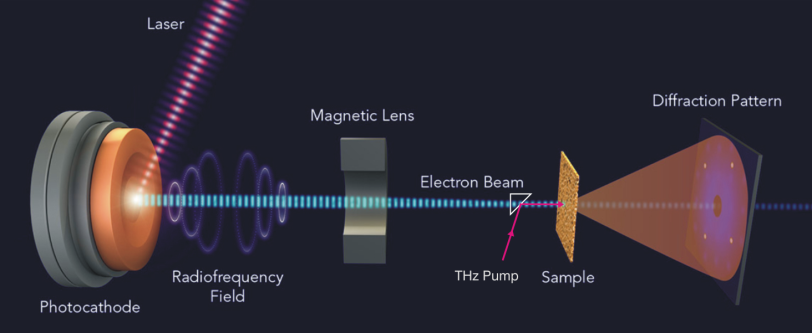SLAC/Stanford team discovers new way of switching exotic properties on and off in topological material
Ultrafast manipulation of material properties with light could stimulate the development of novel electronics, including quantum computers.
By Manuel Gnida
A weird feature of certain exotic materials allows electrons to travel from one surface of the material to another as if there were nothing in between. Now, researchers have shown that they can switch this feature on and off by toggling a material in and out of a stable topological state with pulses of light. The method could provide a new way of manipulating materials that could be used in future quantum computers and devices that carry electric current with no loss.
Topological materials are particularly interesting for these applications because their electronic states are extraordinarily resistant to external perturbations, such as heating, mechanical pressure and material defects. But to make use of these materials, scientists also need ways to fine-tune their properties.
“Here, we’ve found an ultrafast and energy-efficient means of using light as an external perturbation to drive a material in and out of its stable topological state,” said Aaron Lindenberg, the study’s principal investigator and an associate professor at the Department of Energy’s SLAC National Accelerator Laboratory and Stanford University.
The SLAC/Stanford team published their results in Nature.

Controlling topology with light
In mathematics, topology describes how a geometric object can transform into various shapes without losing certain properties. For example, a sphere can morph into a flat disk but not into a doughnut, because that would require poking a hole in it.
In materials, the concept of topology is more abstract, but it similarly leads to extraordinary robustness: Materials in a topological state maintain their exotic properties, such as the ability to conduct electricity with very little loss, under external perturbation.
“These materials offer an exciting platform for understanding new concepts in materials physics, and we’ve been actively learning new ways of utilizing their unique potential,” said Edbert Sie, a fellow at the Geballe Laboratory for Advanced Materials at Stanford working with Lindenberg and one of the new study’s lead authors. Research on topological materials has been honored with the 2016 Nobel Prize in Physics and a 2019 Breakthrough Prize.
Although topological materials are known for their stability, certain perturbations can also drive them out of their stable state. “In our own work, we’re looking for ways to use light and strain to manipulate topological materials and create new material states that could be useful for future applications,” Sie said.
This study focused on a topological material called tungsten ditelluride, which is made of stacked two-dimensional layers. Scientists have already proposed that when the material is in its topological state, the particular arrangement of atoms in those layers can generate what are called Weyl nodes that exhibit unique electronic properties such as zero-resistance conductivity. These points can be thought of as wormhole-like features that tunnel electrons between opposite surfaces of the material.
Sie and his colleagues set out to tweak the material’s properties with pulses of terahertz radiation, an invisible form of light whose wavelengths lie between infrared and microwave radiation. What they found took them by surprise: With the light, they were able to rapidly switch the material between its topological state and a non-topological state, effectively switching the zero-resistance state off and back on again.
“It’s the first time anyone has seen this switching behavior,” said Clara Nyby, a graduate student on Lindenberg’s team and another lead author of the study. “Using terahertz radiation was the key here because its energy can efficiently drive this motion.”

Ultrafast ‘electron camera’ reveals material switch
To find out what exactly happened in the material, the researchers used SLAC’s instrument for ultrafast electron diffraction (UED) – a high-speed “electron camera” – to take rapid snapshots of the material’s atomic structure immediately after it was hit by a terahertz pulse.
They discovered that the pulses shifted neighboring atomic layers in opposite directions, distorting the material’s atomic structure. The structure began to oscillate, with layers swinging back and forth around their original positions (see animation above). Swinging in one direction, the material lost its topological property. Swinging in the other direction, the property reappeared and became more stable.
“There are many atomic motions that can potentially occur in the material,” said co-author Xijie Wang, head of SLAC’s UED team. “The combination of terahertz pulses and UED, used here for the first time, made this experiment possible. It allowed us to quickly identify this particular oscillatory motion.”
Co-author Das Pemmaraju, an associate staff scientist at SLAC, said, “The UED data were also the basis for calculations of the material’s electronic structure and its response to terahertz radiation. Our results demonstrate that the radiation drives the material out of its topological state and then back into it.”

It remains to be seen how this switching mechanism, for which the team has obtained a provisional patent, can actually be used. “It’s early in the game,” Sie said. “But the fact that we can manipulate topological materials in a rather simple manner using light and strain is of great potential.”
Next, the scientists want to apply their method to more materials and investigate how these structural modifications change their electronic properties, further exploring the world of topological materials science.
Parts of this work were done by researchers with the Stanford Institute for Materials and Energy Sciences (SIMES) and the Stanford PULSE Institute, which are jointly operated by SLAC and Stanford. Other institutions involved in the study were Columbia University and Florida State University. The work was primarily supported by the Department of Energy’s Office of Science.
Citation: E. J. Sie, C. M. Nyby, et al., Nature, 3 January 2019 (10.1038/s41586-018-0809-4)
Contact
For questions or comments, contact the SLAC Office of Communications at communications@slac.stanford.edu.
SLAC is a multi-program laboratory exploring frontier questions in photon science, astrophysics, particle physics and accelerator research. Located in Menlo Park, Calif., SLAC is operated by Stanford University for the U.S. Department of Energy's Office of Science.
SLAC National Accelerator Laboratory is supported by the Office of Science of the U.S. Department of Energy. The Office of Science is the single largest supporter of basic research in the physical sciences in the United States, and is working to address some of the most pressing challenges of our time. For more information, please visit science.energy.gov.





